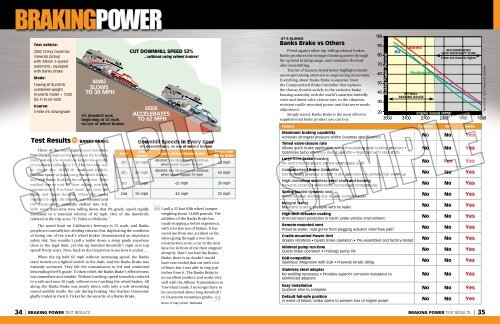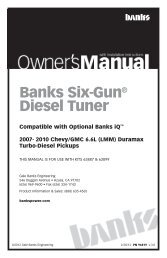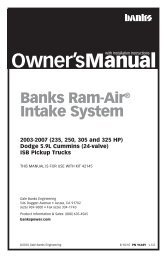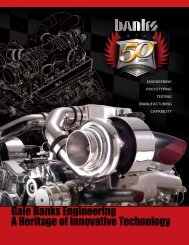Diesel Engine 320 HP - Bankspower - Banks Power
Diesel Engine 320 HP - Bankspower - Banks Power
Diesel Engine 320 HP - Bankspower - Banks Power
Create successful ePaper yourself
Turn your PDF publications into a flip-book with our unique Google optimized e-Paper software.
Test vehicle:<br />
2002 Chevy Duramax<br />
crewcab pickup<br />
with Allison 5-speed<br />
automatic, equipped<br />
with <strong>Banks</strong> Brake<br />
Mode:<br />
Towing @18,650-lb<br />
combined weight<br />
(9,650-lb trailer + 1200<br />
lbs in truck-bed)<br />
Course:<br />
5-mile 6% downgrade<br />
Test Results<br />
BANKS<br />
Slows<br />
to 30 mph<br />
6% downhill runs,<br />
beginning at 55 mph,<br />
no use of wheel brakes<br />
banks brake<br />
Three of the most experienced members<br />
from <strong>Banks</strong>’ engineering group ran the braking<br />
tests, out on the notorious Grapevine stretch<br />
of southern California’s I-5. The first test was<br />
to obtain the 18,650-lb truck-and-trailer’s<br />
baseline speed without using the wheel brakes,<br />
and with <strong>Banks</strong> Brake in the off position. Their<br />
method was to wait for clear sailing, turn the<br />
transmission’s Tow/Haul mode on, crest the<br />
grade and begin descent. When the speed<br />
reached 55 mph, the throttle was released and<br />
the transmission manually shifted into 3rd.<br />
Gear<br />
With more than nine tons rolling down that 6% grade, speed rapidly<br />
increased to a terminal velocity of 62 mph. One of the daredevils<br />
referred to the trip as an “E-Ticket to Oblivion.”<br />
The speed limit on California’s freeways is 55 mph, and <strong>Banks</strong><br />
people are normally law-abiding citizens. But, duplicating the condition<br />
of losing use of the truck’s wheel brakes demonstrated an important<br />
safety risk. You wouldn’t pull a trailer down a steep grade anywhere<br />
close to the legal limit, yet this rig barreled downhill 7 mph over top<br />
speed! Pretty scary. Now, back to the Grapevine to see how it ended …<br />
When the rig held 62 mph without increasing speed, the <strong>Banks</strong><br />
team turned on a lighted switch in the dash, and the <strong>Banks</strong> Brake was<br />
instantly activated. They left the transmission in 3rd and continued<br />
descending the 6% grade. To their relief, the <strong>Banks</strong> Brake’s effectiveness<br />
was immediate and notable. Without lurching, speed smoothly reduced<br />
to a safe and sane 30 mph, without ever touching the wheel brakes. All<br />
along, the <strong>Banks</strong> Brake was nearly silent, with only a soft whooshing<br />
sound audible inside the cab during braking. Our fearless threesome<br />
gladly traded in their E-Ticket for the security of a <strong>Banks</strong> Brake.<br />
5th<br />
4th<br />
cut downhill speed 52%<br />
...without using wheel brakes!<br />
STOCK<br />
Accelerates<br />
to 62 Mph<br />
Downhill Speeds in Every Gear<br />
(6% downhill runs, no use of service brakes)<br />
Start<br />
Speed<br />
55 mph<br />
55 mph<br />
Speed without <strong>Banks</strong> Brake<br />
Aborted: too dangerous to continue<br />
when speed topped 75 mph<br />
Aborted: too dangerous to continue<br />
when speed topped 75 mph<br />
Speed with<br />
<strong>Banks</strong> Brake<br />
72 mph<br />
55 mph<br />
3rd 55 mph 62 mph 30 mph<br />
2nd 55 mph 45 mph 25 mph<br />
“<br />
I pull a 33 foot fifth wheel camper<br />
weighing about 14,000 pounds. The<br />
addition of the <strong>Banks</strong> Brake has<br />
made stopping a better experience,<br />
with a lot less use of brakes. It has<br />
saved me from one accident so far,<br />
when going through a two-lane<br />
construction zone, a car in the next<br />
lane cut in front of me then stopped<br />
abruptly. Had I not had the <strong>Banks</strong><br />
Brake, there is no doubt I would<br />
have rear-ended that car with a lot<br />
of force, but I was able to stop just<br />
inches from it. The <strong>Banks</strong> Brake is<br />
an excellent product and works very<br />
well with the Allison Transmission in<br />
Tow/Haul mode. I no longer have to<br />
be concerned about long downhill 7<br />
to 10 percent mountain grades.<br />
”<br />
Bruce of Clay Center, Nebraska<br />
At a Glance:<br />
<strong>Banks</strong> Brake vs Others<br />
Pitted against other top-selling exhaust brakes,<br />
<strong>Banks</strong> produces the strongest braking power through<br />
the optimal braking range, and maintains the lead<br />
after backshifting.<br />
The list of features listed below highlights <strong>Banks</strong>’<br />
uncompromising attention to engineering innovation.<br />
Everything about <strong>Banks</strong> Brake is superior, from<br />
the Computerized Brake Controller that replaces<br />
the clumsy throttle switch, to the exclusive brake<br />
housing assembly with the world’s smartest butterfly<br />
valve and timed valve closure rate, to the vibrationresistant<br />
cradle-mounted power unit that never needs<br />
adjustment.<br />
Simply stated, <strong>Banks</strong> Brake is the most effective<br />
supplemental brake product you can buy.<br />
20<br />
<strong>Engine</strong> Speed (RPM)<br />
3500 3100 2700 2300 1900 1500<br />
34 | braking power test results braking power test results | 35<br />
100<br />
90<br />
80<br />
70<br />
60<br />
50<br />
40<br />
30<br />
Braking <strong>Power</strong> (Percent)<br />
BD<br />
<strong>Banks</strong><br />
Pacbrake<br />
OPTIMAL<br />
BRAKING RANGE<br />
RECOMMENDED<br />
SAFE BACKSHIFT ZONE<br />
From 3rd Gear & Higher<br />
Feature Pacbrake BD <strong>Banks</strong><br />
Maximum braking capability<br />
Achieves strongest pressure within Duramax specifications<br />
No No Yes<br />
Timed valve-closure rate<br />
Allows quick brake application without exceeding peak braking pressure •<br />
Optimizes turbo efficiency during upshifts • Important with stick shifts<br />
No No Yes<br />
Large-bore brake housing<br />
No restriction to engine airflow when brake is off<br />
No Yes Yes<br />
Computerized Brake Controller<br />
Electronically provides smooth brake operation • Automatic fast warm-up<br />
No No Yes<br />
High chromium stainless steel shaft-and-bearing<br />
Prevents sticking • Withstands hot exhaust temperatures<br />
No No Yes<br />
Spring-loaded dynamic seal<br />
Prevents valve sticking due to soot contamination<br />
No No Yes<br />
Integral O-ring<br />
Maintains braking pressure with no leaks<br />
No No Yes<br />
High-tech actuator coating<br />
Anti-corrosion protection in harsh under-vehicle environment<br />
No No Yes<br />
Remote-mounted vent<br />
Prevents water, road grime from plugging actuator relief-flow path<br />
No No Yes<br />
Cradle-mounted <strong>Power</strong> Unit<br />
Isolates vibrations • Quiets brake operation • Pre-assembled and factory-tested<br />
No No Yes<br />
Minimal pump run-time<br />
Quiets brake operation • Prolongs pump life<br />
No No Yes<br />
EGR-compatible<br />
Seamless integration with EGR • Prevents erratic idling<br />
No No Yes<br />
Stainless steel adapter<br />
No welding necessary • Provides superior corrosion resistance to<br />
aluminized adapters<br />
No No Yes<br />
Easy installation<br />
Quickest time to complete<br />
No No Yes<br />
Default fail-safe position<br />
In event of failure, brake opens to prevent loss of engine power<br />
No No Yes<br />
Test Vehicle: 2001 Chevy 6.6L Duramax









